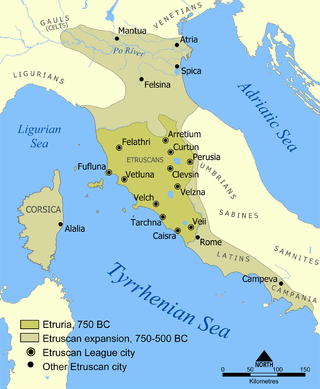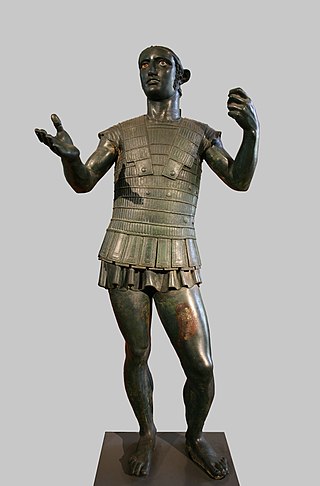Related Research Articles

Aius Locutius or Aius Loquens, was a Roman deity or numen associated with the Gallic invasions of Rome during the early 4th century BC.

In ancient Roman religion, the diiNovensiles or Novensides are collective deities of obscure significance found in inscriptions, prayer formulary, and both ancient and early-Christian literary texts.

Etruscan religion comprises a set of stories, beliefs, and religious practices of the Etruscan civilization, heavily influenced by the mythology of ancient Greece, and sharing similarities with concurrent Roman mythology and religion. As the Etruscan civilization was gradually assimilated into the Roman Republic from the 4th century BC, the Etruscan religion and mythology were partially incorporated into ancient Roman culture, following the Roman tendency to absorb some of the local gods and customs of conquered lands. The first attestations of an Etruscan religion can be traced back to the Villanovan culture.

Aita is the name of the Etruscan equivalent to the Greek Hades, the god of the underworld.

In the religion of ancient Rome, a haruspex was a person trained to practise a form of divination called haruspicy (haruspicina), the inspection of the entrails of sacrificed animals, especially the livers of sacrificed sheep and poultry. The reading of omens specifically from the liver is also known by the Greek term hepatoscopy.

Pyrgi was originally an ancient Etruscan town and port in Latium, central Italy, to the north-west of Caere. Its location is now occupied by the borough of Santa Severa. It is notable for the discovery here of the gold tablets, an exceptional epigraphic document with rare texts in Phoenician and Etruscan languages, and also the exceptional terracotta pediment statues from the temple.

Etruscan history is the written record of Etruscan civilization compiled mainly by Greek and Roman authors. Apart from their inscriptions, from which information mainly of a sociological character can be extracted, the Etruscans left no surviving history of their own, nor is there any mention in the Roman authors that any was ever written. Remnants of Etruscan writings are almost exclusively concerned with religion.

Etruscan cities were a group of ancient settlements that shared a common Etruscan language and culture, even though they were independent city-states. They flourished over a large part of the northern half of Italy starting from the Iron Age, and in some cases reached a substantial level of wealth and power. They were eventually assimilated first by Italics in the south, then by Celts in the north and finally in Etruria itself by the growing Roman Republic.
Larissa Bonfante was an Italian-American classicist, Professor of Classics emerita at New York University and an authority on Etruscan language and culture.

The Dii Consentes, also known as Di or Dei Consentes, is an ancient list of twelve major deities, six gods and six goddesses, in the pantheon of Ancient Rome. Their gilt statues stood in the Roman Forum, and later apparently in the Porticus Deorum Consentium.

The Etruscans, like the contemporary cultures of Ancient Greece and Ancient Rome had a persistent military tradition. In addition to marking the rank and power of certain individuals in Etruscan culture, warfare was a considerable economic boon to Etruscan civilization. Like many ancient societies, the Etruscans conducted campaigns during summer months; raiding neighboring areas, attempting to gain territory and combating piracy as a means of acquiring valuable resources such as land, prestige goods and slaves. It is also likely individuals taken in battle would be ransomed back to their families and clans at high cost. Prisoners could also potentially be sacrificed on tombs to honor fallen leaders of Etruscan society, not unlike the sacrifices made by Achilles for Patroclus.

In antiquity, several theses were elaborated on the origin of the Etruscans from the 5th century BC, when the Etruscan civilization had been already established for several centuries in its territories, that can be summarized into three main hypotheses. The first is the autochthonous development in situ out of the Villanovan culture, as claimed by the Greek historian Dionysius of Halicarnassus who described the Etruscans as indigenous people who had always lived in Etruria. The second is a migration from the Aegean sea, as claimed by two Greek historians: Herodotus, who described them as a group of immigrants from Lydia in Anatolia, and Hellanicus of Lesbos who claimed that the Tyrrhenians were the Pelasgians originally from Thessaly, Greece, who entered Italy at the head of the Adriatic sea. The third hypotheses was reported by Livy and Pliny the Elder, and puts the Etruscans in the context of the Rhaetian people to the north and other populations living in the Alps. The first Greek author to mention the Etruscans, whom the Ancient Greeks called Tyrrhenians, was the 8th-century BC poet Hesiod, in his work, the Theogony. He mentioned them as residing in central Italy alongside the Latins. The 7th-century BC Homeric Hymn to Dionysus referred to them as pirates. Unlike later Greek authors, such as Herodotus and Hellanicus, these earlier Greek authors did not suggest that Etruscans had migrated to Italy from elsewhere.
Vegoia is a sibyl, prophet, or nymph within the Etruscan religious framework who is identified as the author of parts of their large and complex set of sacred books, detailing the religiously correct methods of founding cities and shrines, draining fields, formulating laws and ordinances, measuring space and dividing time; she initiated the Etruscan people to the arts, as originating the rules and rituals of land marking, and as presiding over the observance, respect, and preservation of boundaries. Vegoia also is known as Vecu, Vecui, and Vecuvia, as well as Vegoe; her name is also given as Begoe or Bigois.

Civita Castellana is a town and comune in the province of Viterbo, 65 kilometres (40 mi) north of Rome.

Narce was a Faliscan settlement in Italy located 5 kilometers south of Falerii. Its residents spoke an Italic language related to Latin. It was inhabited from the 2nd millennium to the 3rd century B.C. The ancient name of the settlement is uncertain, but it may have been called Fescennium.

Satre or Satres was an Etruscan god who appears on the Liver of Piacenza, a bronze model used for haruspicy. He occupies the dark and negative northwest region, and seems to be a "frightening and dangerous god who hurls his lightning from his abode deep in the earth." It is possible that Satre is also referred to with the word "satrs" in the Liber Linteus, the Etruscan text preserved in Ptolemaic Egypt as mummy wrappings.

The Mars of Todi is a near life-sized bronze warrior, dating from the late 5th or early 4th century BC, believed to have been produced in Etruria for the Umbrian tribe. It was found near Todi, on the slope of Montesanto, in the property of the Franciscan Convent of Montesanto.
Jean MacIntosh Turfa is an American archaeologist and authority on the Etruscan civilization.
Margarita Gleba is an archaeologist and expert on early textiles and other organic materials.
References
- ↑ Turfa, Jean MacIntosh (2012). Divining the Etruscan World: The Brontoscopic Calendar and Religious Practice. Cambridge: Cambridge University Press. p. 61. ISBN 978-1107009073.
- ↑ Jannot, Jean-René (2005). Religion in Ancient Etruria. Translated by Whitehead, Jane. Madison: University of Wisconsin Press. p. 15. ISBN 0299208400.
- ↑ Jannot 2005, p. 25.
- ↑ Quoted in Turfa, Jean MacIntosh (2014). "Etruscan Religion". The Handbook of Religions in Ancient Europe. Abingdon and New York: Routledge. p. 153. ISBN 978-1844657094.
- ↑ de Grummond, Nancy Thomson (2006). Etruscan Myth, Sacred History, and Legend. Philadelphia: University of Pennsylvania Museum of Archaeology and Anthropology. p. 53. ISBN 1931707863.